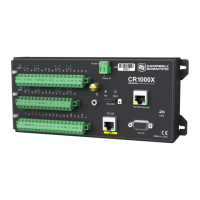Measurement accuracy example
The following example illustrates the effect percent-of-reading and offset have on measurement
accuracy. The effect of offset is usually negligible on large signals.
Example:
l Sensor-signal voltage: approximately 1050 mV
l CRBasic measurement instruction: VoltDiff()
l Programmed input-voltage range (Range) : mV 500 0 (±5000 mV)
l Input measurement reversal (RevDiff): True
l Datalogger circuitry temperature: 10° C
Accuracy of the measurement is calculated as follows:
accuracy = percent-of-reading + offset
where
percent-of-reading = 1050 mV • ±0.04%
= ±0.42 mV
and
offset = 0.5 µV
Therefore,
accuracy = ±(0.42 mV + 0.5 µV) = ±0.4205 mV
6.1.3.8 Minimizing offset voltages
Voltage offset can be the source of significant error. For example, an offset of 3 μV on a 2500 mV
signal causes an error of only 0.00012%, but the same offset on a 0.25 mV signal causes an error
of 1.2%. Measurement offset voltages are unavoidable, but can be minimized. Offset voltages
originate with:
l Ground currents (see Minimizing ground potential differences (p. 49).
l Seebeck effect
l Residual voltage from a previous measurement
Remedies include:
l Connecting power grounds to power ground terminals (G).
l Using input reversal (RevDiff = True) with differential measurements.
l Automatic offset compensation for differential measurements when RevDiff = False.
l Automatic offset compensation for single-ended measurements when MeasOff =
False.
6. Measurements 57

